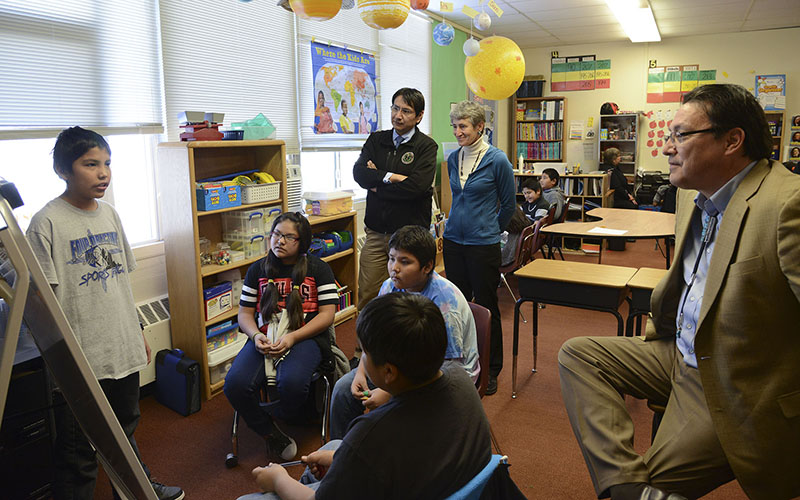
Interior Secretary Sally Jewell, in blue, listens to student at Cove Day School on the Navajo Nation in Red Rock. It and another reservatiobn school had been waiting 12 years for federal funds for repairs. (Photo by Tami A. Heilemann/Interior Department)

Interior Secretary Sally Jewell shares lunch with students at Cove Day School in Red Rock, one of two Navajo Nation schools that got “long overdue” federal funds for renovation. (Photo by Tami A. Heilemann/Interior Department)
WASHINGTON – Interior Secretary Sally Jewell delivered $45 million of “long overdue” construction funds Thursday for two long-neglected schools in the Navajo Nation, the last of 14 schools promised funding there 12 years ago.
The Interior Department had announced last February that funding was finally on the way for Cove Day School and Little Singer Community School, but Congress did not approve the money until last month.
“While this funding is long overdue, it meets critical educational needs to build safe learning environments for Native children, fulfills a broken promise to tribal communities, and clears the way for our new 2016 replacement school construction priority list,” Jewell said, according to a statement from the department. She made the announcement at Cove Day School.
Officials with the Navajo Nation welcomed the funding, but said the tribe’s other schools still need help.
“So these two schools finally got the money,” said Tommy Lewis, superintendent of schools for the Navajo Nation. “Boy, it’s good. We need more.”
The Navajo Nation has 15,000 students in 66 schools – more schools than any other tribe. Many of those are now 40 to 70 years old and have developed safety concerns that run from mildew to falling roofs, Lewis said.
Two-thirds of the 183 schools overseen by the Bureau of Indian Education are 60 years old or older, said Denise Desiderio, policy and legislative director for the National Congress of American Indians.
She said it would cost $1.3 billion to catch up on the backlog of schools needing repair. The bureau has only been allocated $138 million for construction in 2016 – but that was still a $64 million increase from last year.
“At the current rate, it would take several more decades to take our schools up to the same standards,” Desiderio said.
She said NCAI is encouraged by recent efforts to improve schools and happy that some schools make it on the federal government’s annual priority list. But for every 10 schools on the list, there are still 50 to 60 dilapidated schools still needing attention, she said.
“We’re not asking for more,” she said. “We’re just asking for the same school conditions, teachers, resources that are expected anywhere else.”
Cove Day School, built 57 years ago, has already exceeded its projected life span, according to Interior. The school, which has nearly 50 students, lacks a nursing office and adequate teacher housing, and its mechanical, electrical and plumbing systems fail building codes.
Little Singer Community School is relatively new at about 30 years old, but is too small and suffered water damage because of missing roof tiles, the Interior Department said. Lewis said the school is five miles from paved roads, and dirt roads to the school become “treacherous” when it rains and snows.
Both schools have asbestos.
The federal funds will go toward replacing the campus buildings at both schools and improving campus safety at Cove Day School.
Tribes compete to get schools on an annual priority list for federal construction funds, Lewis said. If they make the list, schools can languish there for years: Cove Day School and Little Singer Community Day made the priority list in 2004. And, Lewis said, schools can also be taken off the priority list.
Lewis lamented the process.
“We’re the indigenous people of this country,” he said. “The federal government took away our land. We have a treaty that says the federal government will take care of our education. They have fallen short.”